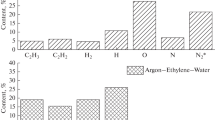Abstract
Methane, ethane, and their mixtures with oxygen have been passed through the silent electric discharge at various operating conditions Beside.carbon oxides and water, formaldehyde and methane, and acetaldehyde and ethanol from ethane were the other major products. The effect of temperature, pressure, discharge voltage, contact time, and oxygen concentration have been examined. The rate of oxygen consumption is almost independent of oxygen concentration and depends mainly on the discharge voltage. The selectivities of methanol formation from methane and ethanol/formation from ethane were 20 and 15%, respectively.
Similar content being viewed by others
References
C. D. Chang,Cutal. Rev. Sci. Eng. 25, 1 (1983).
P. S. Yarlagadda, L. A. Morton, N. R. Hunter. and H. D. Gesser,Fuel Sci. Technol. Int. 5, 169 (1987).
Y. Amenomiya, V. I. Birss, M. Goledzinowski, J. Galuszka, and A. Sanger,Catal. Rev. Sci. Eng. 32, 163 (1990).
J. S. Lee and S. T. Oyama,Catal. Rev. Sci. Eng. 30, 249 (1988).
J. H. Edwards and N. R. Foster,Fuel.Sci. Tech. Int. 4, 365 (1986).
H. D. Gesser and N. R. Hunter, “The Direct Conversion of Methane to Methanol (DMTM ),” inDirect Methane Conversion by Oxidative Processes. Fundamental and Engineering Aspects, E. E. Wolf, ed., Reinhold-VanNostrand, New York (1992), Part I, Chapter 12, p. 403.
R. Pitchai and K. Klier,Cat. Rev. Sci. Eng. 28, 13 (1986).
V. I. Vedeneev, M. Ya. Goldenberg, N. I. Gorban. and M. A. Teitelboim,Kinet. Katal. 29, 7 (1988).
G. Glocker and S. C. Lind,The Electrochemistry of Gases and Other Dielectrics, Wiley, New York (1939).
J. R. Holloban and A. T. Bell (eds.).Techniques and Application of Plasma Chemistry, Wiley, New York (1974).
A.-P. B. d'Enghien, J. Vrebosh, and A. van Tiggelen, Bull. Soc.Chim. Fr. No. 6, 2321 (1968).
P. Meubus and G. Jean,Plasma Chem. Plasma Process.9, 527 (1989).
H. D. Gesser, N. R. Hunter, and C. B. Prakash,Chem. Rev. 85, 235 (1985).
N. R. Hunter, H. D. Gesser, L. A. Morton, and P. S. Yarlagadda,Appl. Catal. 57, 45 (1990).
R. G. Mallinson, C. M. Slipcevich, and S. Rusek, Methane Partial Oxidation in Alternating Electric Field, Preprints of the 194th National Meeting of the ACS, Section of Fuel Chemistry, New Orleans, Louisiana,32(3), 366 (1987).
P. S. Yarlagadda, L. A. Morton, N. R. Hunter, and H. D. Gesser,Ind. Eng. Chem. Res. 27, 252 (1988).
H. D. Gesser, N. R. Hunter, L. A. Morton, and P. S. Yarlagadda,Energy Fuels 5, 423 (1991).
Author information
Authors and Affiliations
Rights and permissions
About this article
Cite this article
Shepelev, S.S., Gesser, H.D. & Hunter, N.R. Light paraffin oxidative conversion in a silent electric discharge. Plasma Chem Plasma Process 13, 479–488 (1993). https://doi.org/10.1007/BF01465877
Received:
Accepted:
Issue Date:
DOI: https://doi.org/10.1007/BF01465877




